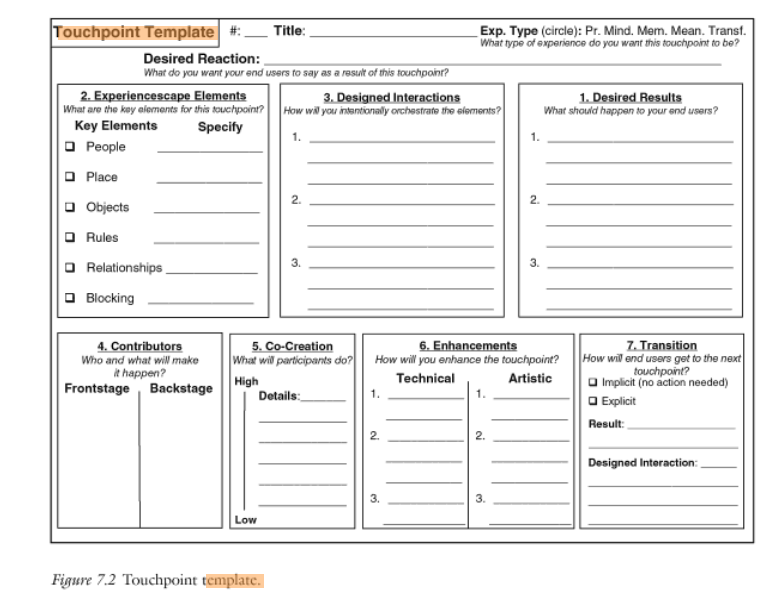I recently tried to take the Touchpoint Template from the book Designing Experiences and attempted to create an experience with it. It was a failed attempt but I think I learned some things.
The Touchpoint Template
First, what is the Touchpoint Template? It’s Duerden and Rossman’s model of a touchpoint. A touchpoint is a specific interaction someone has with your experience. It inclues the people, places, and things involved in the interaction, the desired interactions and results and some other elements describing the experience. It gives you a a complete picture of the experience.
Here’s a screenshot of their template:

My thinking for this experiment was that if I designed using this template, then I would be sure to have all the pieces I need and I would save time and effort by being focused.
But It Didn’t Work
I had problems taking the template and applying it to the process of making an experience. The ideas weren’t really coming to me and the ideas I did come up with seemed dull and mechanical. The template was not inspiring and the ideas I came up with seemed soulless and not born of creative magic but born out of a need to fill in the blanks of the template. It was like doing a madlib and expecting a good story. It was mostly stupid, sometimes useful, never inspiring.
It felt more like trying to create human life by collecting some body parts and sewing them together. There was no life to it. That’s not how it’s created.
I’ve had similar problems with things like the Business Model Canvas and Value Proposition Canvas books. They promise (at least implicitly): just fill in the blanks and problem solved.
So what was the problem?
For one thing, the creative process is not so linear, at least for me. My ideas come from freeform writing, playing with associations, using external sources as jumping off points, talking to friends, taking breaks and drinking lots of coffee. I can just turn it on and fill out the boxes like I was doing my accounting paperwork or organizing a bookshelf. But ideation is not a logical process and much of the work is done by the unconscious work of intuition. The templates come off (to me) as an attempt to formulate the process of human creativity. Calling these templates “canvases” implies that it’s where you do creative work but I think that’s misleading.
Just because you can map a model out retrospectively doesn’t mean your model is a good tool to create the thing it mapped. It’s like diagraming sentences. Sure it will explain which words are nounts and which are verbs and do all the other classifications and relationships of words. But no one has ever learned to speak by studying diagrammed sentences.
So are these canvases useful at all?
I’d say definitely. But probably not as a first step in your design process and not as a creative tool. Where I think they excel is by being a checklist. After you *think* you understand how it all works, try putting it into the canvas or template. Are there parts missing? You might see things like: “oh, I didn’t think about who is going to run this” or “oh, what are we doing for the transition after this to the next touchpoint?”. It helps reveal gaps.
When should you bring it in? I’m not sure. You could use it early to perhaps prime your mind for all the parts you need to consider during ideation. On the other hand, doing that might pollute the waters or constrict the creative freedom that is sometimes needed to discover the best ideas.
Maybe you wait until after you can write a one page summary of how your whole experience works (or how you think it works). Then you can see the gaps in the experience you’re creating. For example, you might see that you are missing a missing transition. Once you realize that you can set the template aside and jump back to the creative domain to ideate a solution for the transition problem.
The creative process is its own post (or many) but my belief is that if you start with questions like “Why?”, “Who am I trying to help?”, “How am I trying to help them?”, and “What do I want them to feel?” and then use the templates and canvases, you’ll get to better solutions faster.